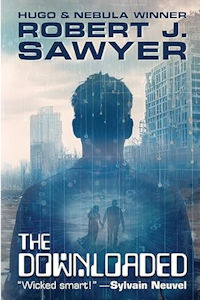Paul Di Filippo Reviews Robert J. Sawyer’s The Downloaded
 The Downloaded, Robert J. Sawyer (Shadowpaw Press 978-1989398999, trade paperback, 199pp, $14.95) May 2024
The Downloaded, Robert J. Sawyer (Shadowpaw Press 978-1989398999, trade paperback, 199pp, $14.95) May 2024
It’s a testament to Robert Sawyer’s skill—and his generational wisdom—that he has created, with his latest book, a novel that is at once exuberantly old-school and utterly au courant. It reads like Greg Egan rebooting Neil R. Jones’s Professor Jameson cycle. This book exemplifies the “best of both worlds” approach that charts a viable future for SF: don’t haughtily throw away all the classics and the toolkit refined by past genre masters, while trying to reinvent the wheel and appear determinedly hip. Instead, acknowledge, adapt and advance.
Before dipping into the plot, I should mention that the novel utilizes a familiar but not totally omnipresent story-telling structure: multiple first-person narrators, alternating from one chapter to the next in non-predictable fashion. But there’s no “Rashomon Effect,” intended or actual. With very little overlapping of events, the plot is handed off from one character to the next in a logical, sequential fashion. The result is very readable and variegated, thanks to the different voices.
We start with a fellow named Dr. Jürgen Haas, as he recounts some events impossible in a real world setting, and we quickly twig to the fact that he is extant in a full-bore virtual environment—not the kind mediated through glasses and haptics, but the kind of platform that hosts the digitized personality itself. His antics are interrupted by a woman named Letitia, who manifest bearing bad news. This proves to be Captain Letitia Garvey, head of mankind’s sublight expedition to Proxima Centauri. We don’t immediately learn what the emergency is that caused her to interrupt Haas—a chapter from the POV of a murderous convict named Roscoe Koudoulian—mysteriously intervenes—but she does fill us in on the mechanics of cryonic suspension. And here’s where Sawyer introduces a nice shiny novum.
It turns out that freezing a person breaks the numinous but real bond between their physical brain and their “quantum-entangled” consciousness or soul, sending the latter off to destruction. Thus, the first corpsicles, when reawakened, were empty vessels. But scientists discover that if you abstract the person’s consciousness first, as a digital upload, and save it safely in a quantum computer, the corpsicle and soul can later be successfully reunited.
To cut to the chase, the reader soon learns that all the astronauts of the long-centuried voyage to Proxima were packed frozen onboard their spaceship, while their souls were stored in a computer on Earth—a substrate running at such a reduced clockrate that the souls would languish only for a few subjective years, rather than actual centuries. Once the frozen bodies arrived at their destination, their two halves of each person were to be automatically reunited, with quantum-entanglement bridging the lightyears.
The arrival time seems like now to Captain Garvey, but nothing is happening. So she forces an awakening of herself and Haas. But they do not revive inside the spaceship.
Here’s the shocking reveal that comes about a quarter of the way into the book, and if you don’t want to know, stop reading! Myself, I think we need to disclose it to judge the rest of the book.
Their cryo-pods are still on Earth, in the very installation where they were to be staged to orbit. The facility is still functioning, thanks to robot maintenance, and the clocks show that, indeed, five centuries have passed.
But outside the building are nothing but the Wellsian ruins of the city of Waterloo, Canada: a realm of overgrown desolation, empty of people.
The rest of the novel concerns what exactly happened to Earth, and how the crew of the starship, revivified, will cope with their fate. Complicating the matter is a band of cryo-preserved convicts, also by necessity reawakened, who happen to share the facility. Is the fate of humanity to be Lord of the Flies or Earth Abides? But don’t get too sure of where things are heading, since Sawyer tosses in a half-dozen more complications and twists, including a murder and some sketchy robots.
The time-frame of events is very compressed, just a few days, but Sawyer packs a lot of character development and action into the tale. (One of the astronauts chose to experiment in VR with their gender identity, and upon re-embodiment, they face personal challenges that serve as a fine subplot.) There are no roving hordes of mutants or zombies, but the very mundanity of mankind’s fall and near-extinction are more poignant than any of those old stale tropes.
Sawyer sticks the landing as well, taking his characters through their crisis to a satisfying coda.
One last shoutout to a minor classic that resonates with Sawyer’s book is seen in his repeated use of the phrase “Why call them back from heaven?” Fans of our own Bard of the Bucolic Midwest, Clifford Simak, might recall one of Simak’s later novels with that title. Sawyer is much like Simak in his earnest, open-handed, humanist delivery and effects, and thus, everything old is new again.
 While you are here, please take a moment to support Locus with a one-time or recurring donation. We rely on reader donations to keep the magazine and site going, and would like to keep the site paywall free, but WE NEED YOUR FINANCIAL SUPPORT to continue quality coverage of the science fiction and fantasy field.
While you are here, please take a moment to support Locus with a one-time or recurring donation. We rely on reader donations to keep the magazine and site going, and would like to keep the site paywall free, but WE NEED YOUR FINANCIAL SUPPORT to continue quality coverage of the science fiction and fantasy field.
©Locus Magazine. Copyrighted material may not be republished without permission of LSFF.







